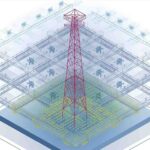

In a world where digital access is vital for progress, rural areas often remain on the sidelines of the connectivity revolution. However, with the advent of wireless telecom infrastructure, this landscape is changing. Wireless technology is set to bridge the digital divide, making connectivity a reality for rural communities where it has historically been out of reach. This matters because connectivity is no longer a luxury; it is a lifeline that enables access to education, healthcare, and economic opportunities.
Understanding Wireless Telecom Infrastructure
Definition and Components
Wireless telecom infrastructure refers to the network systems and equipment that enable wireless communication and data transfer without the use of physical cables. Its main components include:
- Wireless Network Infrastructure Design: This is the overarching framework that defines how the wireless network will operate, including network planning, topology, and capacity.
- Telecom Tower Design: These structures support antennas and communication devices. Properly designed towers are essential to ensure broad coverage, especially in rural and remote areas.
Evolution of Wireless Technology
The evolution of wireless technology, from 3G to 5G, has significantly improved the reach and speed of wireless networks. While early technologies provided basic mobile services, the introduction of 5G offers ultra-fast speeds and low latency, which are transforming how remote communities access services. These advancements are making it not only possible but also scalable, to extend wireless connectivity to rural regions that were once too costly to serve.
Challenges of Rural Connectivity
Geographic and Economic Barriers
Rural regions face several challenges in building robust connectivity infrastructure. The rugged terrain and dispersed population often make it difficult and expensive to deploy traditional wired infrastructure. Additionally, the high cost of installation and maintenance in sparsely populated areas deters investment from private companies, further exacerbating the digital divide.
Limited Access to High-Speed Internet
The lack of reliable broadband services in rural areas limits access to essential services like telemedicine, online education, and e-commerce. In today’s hyper-connected world, not having access to high-speed internet can significantly hinder opportunities for growth and development in these communities.
The Role of Wireless Network Design
Importance of Structural Analysis in Tower Design
Proper structural analysis of telecom towers is critical to ensure that they can withstand extreme weather conditions such as high winds, earthquakes, and heavy snowfalls. Without robust infrastructure, wireless networks may face disruptions, particularly in rural areas where environmental conditions can be harsh.
Mount Analysis for Reliable Connectivity
Mount analysis is key to determining the best positioning of antennas and equipment to optimize signal strength and coverage. By strategically placing antennas on mountain tops or high terrain, telecom companies can improve the reach of their wireless networks, ensuring reliable connectivity even in remote locations.
Innovations in Wireless Network Infrastructure
The future of rural connectivity is being shaped by innovative solutions in network design and deployment. Key innovations include:
- Modular Towers: These are lightweight and easily deployable towers that reduce installation costs, making them ideal for rural and difficult-to-reach areas.
- AI-Driven Network Optimization: Artificial intelligence is being used to predict network traffic patterns and optimize the allocation of resources. This ensures efficient usage of bandwidth and improves service quality in underserved areas.
Key Strategies for Expanding Rural Connectivity
Leveraging New Technologies
Emerging technologies like low Earth orbit (LEO) satellites and 5G are game-changers for rural connectivity. LEO satellites provide a global internet coverage that reaches even the most remote corners of the world, while 5G promises faster speeds and more reliable connectivity for rural businesses, farms, and schools.
Collaboration Between Public and Private Sectors
Public-private partnerships are essential to expanding rural connectivity. Governments often provide funding and regulatory support, while telecom companies bring in the technical expertise and infrastructure. Such collaborations enable the scaling of projects and ensure broader and more equitable access.
Role of Mobile Network Operators (MNOs)
Mobile network operators (MNOs) play a pivotal role in bringing wireless networks to underserved areas. By investing in rural infrastructure and maintaining the networks, MNOs help deliver critical services like mobile broadband, which can have transformative effects on rural communities.
Case Studies
Success Stories in USA and Canada
- USA: The Federal Communications Commission (FCC) Rural Digital Opportunity Fund has facilitated significant investments in broadband infrastructure in rural America, resulting in improved access to high-speed internet in many isolated areas.
- Canada: The Canadian government’s initiative to connect rural areas, supported by private investment from telecom companies, has brought broadband to over 90% of rural households, enhancing economic opportunities and access to services.
Examples from Developing Countries
In countries across Africa and South Asia, wireless telecom is helping bridge the connectivity gap. For example, in India, mobile networks have enabled farmers to access weather forecasts, market prices, and agricultural training via their phones, significantly improving productivity and livelihoods.
The Economic and Social Impact
Boosting Local Economies
Reliable internet access enables rural communities to participate in the digital economy. E-commerce, agricultural innovation, and small business growth are all spurred by access to broadband. These developments create jobs, improve incomes, and reduce rural-to-urban migration.
Enhancing Education and Healthcare
Access to digital resources is transforming education and healthcare in rural areas. Telemedicine allows remote consultations with specialists, while online learning platforms ensure that students in rural regions can access the same quality of education as their urban counterparts.
Future Trends in Wireless Telecom Infrastructure
Role of 5G and Beyond
5G promises to revolutionize rural connectivity with faster speeds and lower latency, enabling advanced technologies like autonomous vehicles, remote surgeries, and high-quality video conferencing in underserved regions. Looking ahead, 6G could further expand these capabilities, making connectivity even more ubiquitous and reliable.
Sustainable and Green Telecom Solutions
As telecom infrastructure expands into rural areas, sustainability is becoming increasingly important. Solar-powered telecom towers and energy-efficient designs are setting new standards for environmentally friendly infrastructure deployment, ensuring that rural connectivity does not come at the cost of the planet.
You may also like: “Mount Analysis: A Comprehensive Handbook for In-Depth Understanding”
Conclusion
The rural connectivity revolution, fueled by wireless telecom infrastructure, is transforming how remote communities access essential services and resources. Through innovation, collaboration, and investment, rural areas are overcoming geographic and economic challenges to become digitally empowered. By bridging the digital divide, wireless telecom is paving the way for a more inclusive, connected future where every community, no matter how remote, has the opportunity to thrive.
Latest News



